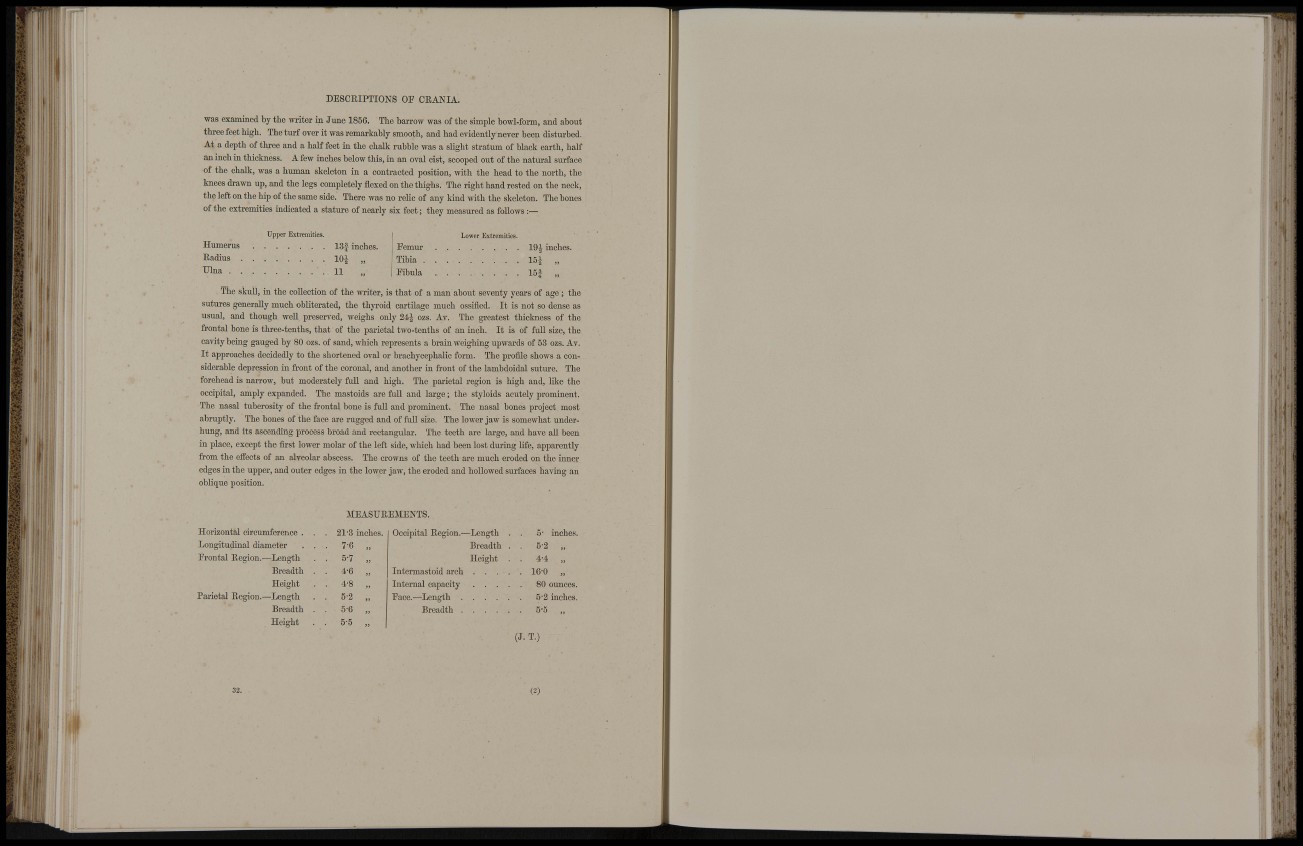
i i ili i l «
' i M
M?:DESCRIPTIONS OF CRANIA.
was examined by the writer in June 1856. The barrow was of the simple bowl-form, and about
three feet high. The tui-f over it was remarkably smooth, and had evidently never been disturbed.
At a depth of three and a half feet in the chalk rubble was a slight stratum of black earth, half
an inch in thickness. A few inches below this, in an oval cist, scooped out of the natural surface
of the chalk, was a human skeleton in a contracted position, with the head to the north, the
knees di'awn up, and the legs completely flexed on the thighs. The right hand rested on the neck,
the left on the hip of the same side. There was no relic of any kind with the skeleton. The bones
of the extremities indicated a stature of nearly six feet; they measured as foUows :—
Upper Extremities.
Humerus I3f inches.
Radius 101
Ulna .1 1
Lower Extremities.
Pemur 19J inches.
Tibia 15i „
Fibula 15f „
The skuU, in the collection of the writer, is that of a man about seventy years of age; the
sutures generally much obliterated, the thyroid caxtilage much ossified. It is not so dense as
usual, and though well preserved, weighs only ozs. Av. The greatest thickness of the
frontal bone is three-tenths, that of the parietal two-tenths of an inch. It is of full size, the
cavity being gauged by 80 ozs. of sand, which represents a brain weighing upwards of 53 ozs. Av.
It approaches decidedly to the shortened oval or brachycephalic form. The profile shows a considerable
depression in front of the coronal, and another in front of the lambdoidal suture. The
forehead is narrow, but moderately fuU and high. The parietal region is high and, like the
occipital, amply expanded. The mastoids are fuU and large; the styloids acutely prominent.
The nasal tuberosity of the frontal bone is full and prominent. The nasal bones project most
abruptly. The bones of the face are rugged and of full size. The lower jaw is somewhat under-
Inmg, and its ascending process broad and rectangular. The teeth are large, and have all been
in place, except the first lower molar of the left side, which had been lost dui-ing life, apparently
from the effects of an alveolar abscess. The crowns of the teeth are much eroded on the inner
edges in the upper, and outer edges in the lower jaw, the eroded and hollowed surfaces having an
obKque position.
MEASUREMENTS.
' 1
•ill
- ' I
Horizontal circumference . . 21-3 inches. Occipital Region.--Length . 5- inches.
Longitudinal diameter . . • 7-6 „ Breadth . • 5-2 „
Frontal Region.—Length . 5-7 „ Height . • 4-4 „
Breadth . . 4-6 „ Intermastoid arch . 16-0 „
Height . 4-8 „ Internal capacity 80 ounces.
Parietal Region.—Length • 5-2 „ Face.—Length . 5-2 inches.
Breadth . • 5-6 „ Breadth • 5-5 „
Height . . 5-5 „
(J. T.)
: '
r" •
h
h .
lit'32. (2)
tn , ÏÎII' 1